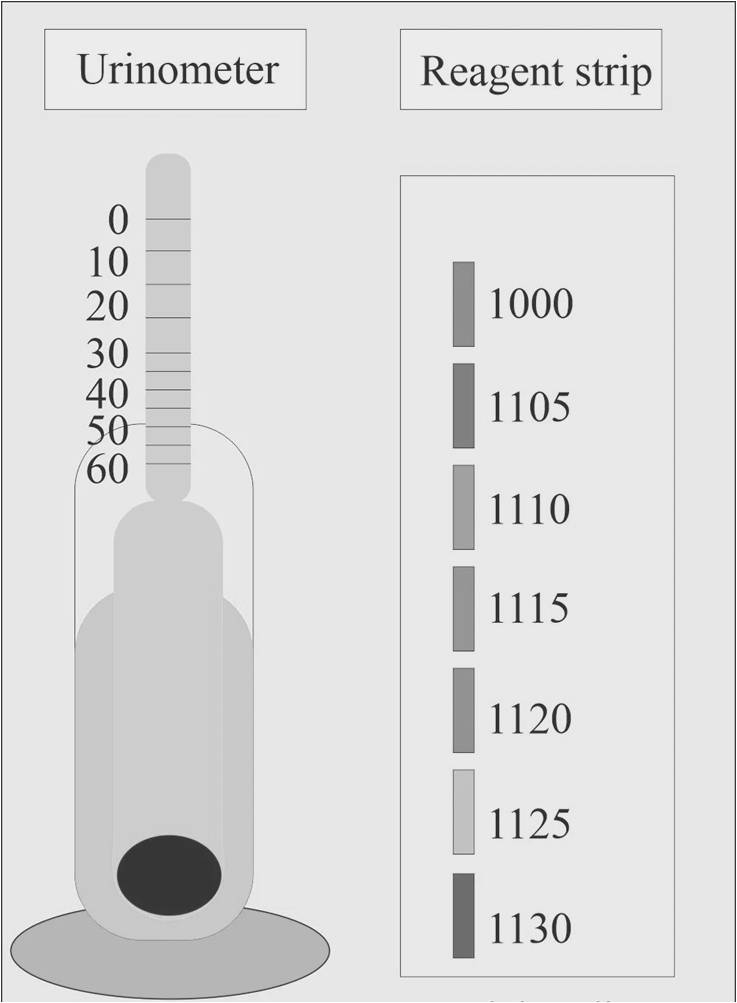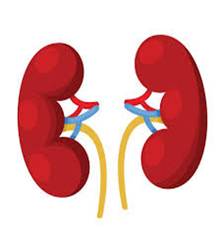Urinometer: It is a type of hydrometer that is used to measure the specific gravity of urine. Specific gravity is a measure of the density of a liquid compared to the density of water. It is typically made of glass and consists of a float with a weighted bulb at the bottom and a calibrated stem. The urinometer is placed in a sample of urine and the float will rise or fall depending on the specific gravity of the urine. The specific gravity is read at the point where the bottom of the meniscus (the curved surface of the urine) intersects the calibrated stem. The concentration of urine is reflected by its specific gravity, which can be a key sign of hydration levels and kidney health. It normally operates as follows:
Principle:
On the basis of buoyancy, the urinometer works. The density (specific gravity) of a liquid determines how much an object will sink or float when submerged in it. It is measures how far into a urine sample it sinks, and the depth is used to determine the specific gravity.
Components:
A typical urinometer consists of a long, slender glass or plastic tube with a weighted bulb at one end. The bulb helps the float vertically in the urine sample.

Urinometers are used for a variety of purposes, including:
- To assess kidney function: A low specific gravity may indicate that the kidneys are not concentrating urine properly, which can be a sign of kidney disease.
- To diagnose diabetes: A high specific gravity in the presence of glucose in the urine is a sign of diabetes.
- To monitor the hydration status of patients: A high specific gravity may indicate dehydration.
- To monitor the response to treatment for certain conditions, such as heart failure and cirrhosis.
How to use a urinometer:
- Collect a sample of fresh urine in a clean container.
- Fill a glass cylinder with the urine sample to about two-thirds full.
- Gently insert the urinometer into the urine sample.
- Spin the urinometer gently to remove any air bubbles.
- Read the specific gravity at the point where the bottom of the meniscus intersects the calibrated stem.
Procedure:
- A urine sample is collected in a container.
- The urinometer is carefully placed into the urine sample, ensuring it is fully immersed.
- The urinometer will float in the urine, with part of it submerged and part of it above the surface.
- The specific gravity is determined by reading the scale on the urinometer at the point where the liquid surface intersects the scale. This reading is taken from the meniscus (the curved surface of the liquid).
Specific Gravity Measurement:
The specific gravity of urine is typically measured on a scale that ranges from around 1.000 (representing the density of water) to above 1.030. The specific gravity of normal urine typically falls within the range of 1.005 to 1.030, depending on factors like hydration and diet. A higher specific gravity indicates more concentrated urine, while a lower value suggests more dilute urine.
An urinometer is an instrument used to measure the specific gravity of urine. It is a type of hydrometer that measures the density of a liquid relative to the density of water. The specific gravity of urine is a measure of the concentration of solutes in urine, which is determined by the kidneys’ ability to concentrate urine.
It consists of a float, a weight, and a stem. The float is an air-filled glass tube that contains a calibrated weight at the bottom and a stem at the top. The stem is marked with numbers that indicate the specific gravity of the urine. The urinometer works on the principle of buoyancy. When the urinometer is placed in urine, it floats higher than it would in water because urine is denser than water. The degree to which the urinometer floats is proportional to the specific gravity of the urine
To measure the specific gravity of urine using an urinometer, the urine sample must be at room temperature. The urinometer is then gently inserted into the urine sample, making sure that it does not touch the sides or bottom of the container. The urinometer is allowed to float freely, and the specific gravity is read from the calibrated stem at the level of the urine surface. The specific gravity of urine is typically between 1.003 and 1.030 1.
Interpretation:
The specific gravity measurement can provide valuable information about a person’s hydration status and kidney function. High specific gravity may indicate dehydration or certain kidney disorders, while low specific gravity may suggest overhydration or other kidney issues.
It’s important to note that while urinometers are still used in some medical settings, they are gradually being replaced by automated urine analyzers, which provide more precise and efficient measurements of urine specific gravity and can also perform additional tests on the urine sample. Automated analyzers are often preferred in modern clinical laboratories due to their accuracy and ease of use. However, urinometers may still be used in situations where access to advanced laboratory equipment is limited.









